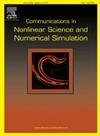Hidden memory chaotic attractors in simple nonequilibrium fractional order systems
IF 3.8
2区 数学
Q1 MATHEMATICS, APPLIED
Communications in Nonlinear Science and Numerical Simulation
Pub Date : 2025-06-02
DOI:10.1016/j.cnsns.2025.108970
引用次数: 0
Abstract
A computational bifurcation diagram of nonlinear fractional order systems may provide a visual representation of understanding possible dynamics in a wide range of system parameters and associated fractional orders. This observed phenomenon has sparked new interest in the question of mathematically sound and rigorous proofs of the existence of such dynamics. No mathematical foundation for the stability of bifurcations has been developed for fractional order systems, and roughly computational attractors are less understood. A famous hidden memory chaotic attractor is the typical class of attractor that does occur in nonlinear fractional order systems without any known bifurcations of any existing attractors. It has been found that such attractors are fundamental and localized with nonlinear fractional-order systems with no equilibrium points. Many intuitive examples are constructed, and the governing dynamics are hidden memory chaotic attractors.
简单非平衡分数阶系统的隐藏记忆混沌吸引子
非线性分数阶系统的计算分岔图可以提供一种理解在大范围系统参数和相关分数阶下可能的动力学的可视化表示。这种观察到的现象引发了人们对这种动力学存在的数学上合理和严格的证明的新兴趣。分数阶系统的分岔稳定性没有数学基础,粗略的计算吸引子也很少被理解。一种著名的隐记忆混沌吸引子是一类典型的吸引子,它确实存在于非线性分数阶系统中,而不存在任何已知的吸引子分叉。这些吸引子对于非线性分数阶系统是基本的和局域的,并且没有平衡点。构造了许多直观的例子,控制动力学是隐藏的记忆混沌吸引子。
本文章由计算机程序翻译,如有差异,请以英文原文为准。
求助全文
约1分钟内获得全文
求助全文
来源期刊

Communications in Nonlinear Science and Numerical Simulation
MATHEMATICS, APPLIED-MATHEMATICS, INTERDISCIPLINARY APPLICATIONS
CiteScore
6.80
自引率
7.70%
发文量
378
审稿时长
78 days
期刊介绍:
The journal publishes original research findings on experimental observation, mathematical modeling, theoretical analysis and numerical simulation, for more accurate description, better prediction or novel application, of nonlinear phenomena in science and engineering. It offers a venue for researchers to make rapid exchange of ideas and techniques in nonlinear science and complexity.
The submission of manuscripts with cross-disciplinary approaches in nonlinear science and complexity is particularly encouraged.
Topics of interest:
Nonlinear differential or delay equations, Lie group analysis and asymptotic methods, Discontinuous systems, Fractals, Fractional calculus and dynamics, Nonlinear effects in quantum mechanics, Nonlinear stochastic processes, Experimental nonlinear science, Time-series and signal analysis, Computational methods and simulations in nonlinear science and engineering, Control of dynamical systems, Synchronization, Lyapunov analysis, High-dimensional chaos and turbulence, Chaos in Hamiltonian systems, Integrable systems and solitons, Collective behavior in many-body systems, Biological physics and networks, Nonlinear mechanical systems, Complex systems and complexity.
No length limitation for contributions is set, but only concisely written manuscripts are published. Brief papers are published on the basis of Rapid Communications. Discussions of previously published papers are welcome.
 求助内容:
求助内容: 应助结果提醒方式:
应助结果提醒方式:


